Hp Pavilion X 360 2 in 1 Touch Screen 14m Cd0003dx I5 Review Pc Magazine
The HP Pavilion x360 14 2-in-1 laptop comes in many flavors, and ours (14m-dh0003dx) should please productivity-minded professionals with its polish quad-core performance and a keyboard that feels great. Given that it's $700 from All-time Buy earlier discounts (though we've recently spotted it for merely $560), nosotros would have liked a bit more battery life, though.
This review is part of our ongoing roundup of the best laptops. Go there for data on competing products and how we tested them.
Configuration
HP offers a dizzying array of Pavilion x360 models in 11-, 14-, and xv-inch sizes, with the xiv-inch configurations ranging from eighth-gen dual-cadre Intel Core i3 systems up to 10th-gen Core i7 quad-core Comet Lake CPUs. Here's what's under the hood of our middle-of-the-road 14-inch Pavilion x360 14m-dh0003dx):
- CPU: Quad-cadre Intel Core i5-8265U
- RAM: 8GB DDR4
- GPU: Integrated Intel UHD Graphics 620
- Display: 14-inch 1920 x 1080 IPS touchscreen
- Storage: 128GB SSD
At start blush, nosotros've got the makings of a solid productivity workhorse hither, with a quad-core Core i5 Whiskey Lake CPU that should be able to breeze through nigh daily computing and Office tasks and tackle some CPU-intensive tasks, such as video processing and database work. The 8GB of RAM, typical for a laptop in this price range, should assist smooth out multitasking kinks (although 16GB of RAM would be even better), and the total-Hard disk IPS touchscreen should offer reasonably sharp resolution with solid viewing angles.
The 128GB solid-state bulldoze is on the small side, however, leaving you with just about 90GB of storage once Windows, Function, and other miscellaneous apps and utilities are accounted for. Given the cramped SSD, you'd probably want to lean on deject storage or an external drive.
A similar Pavilion x360 fourteen is officially $900 on HP.com with 12GB of RAM and a 256GB SSD, but only $590 with discounts equally of presstime.
Design
HP has been adding more than and more than snazzy pattern elements to its Pavilion x360 series. This detail ii-in-1 bears many of those hallmarks, particularly the "hourglass" edges that allow you to open up the Pavilion from the front, left, or right sides, too as the shiny aluminum trim and the matte hat stamped with the HP logo.
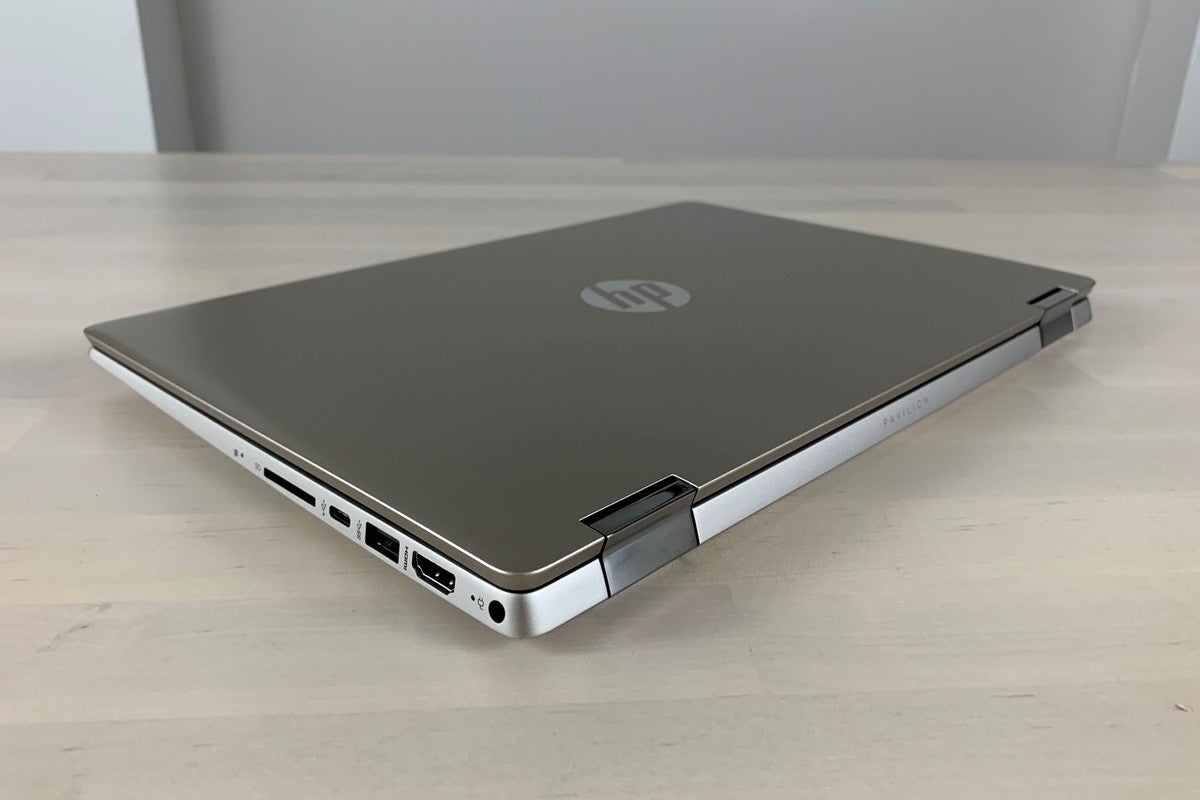 Ben Patterson/IDG
Ben Patterson/IDG The HP Pavilion x360 boasts a sleek contour and a swell "hourglass" edge.
The fourteen-inch, sixteen:9 "micro-border" display does indeed have reasonably thin bezels along the top and sides, although the lesser bezel is pretty mesomorphic. Below the hinges sits an attractive, diamond-cut grille for the Bang & Olufsen speakers (more than on them in a moment), along with the silver-colored palm residuum and keyboard. An understated Pavilion logo sits near the bottom-left border of the keyboard.
Every bit a 2-in-1 system, the Pavilion x360's lid tin can swivel all the way around for tablet use. You tin besides tent the laptop on a desk, or identify it keyboard-down with the display tilted back in kiosk style. The Pavilion x360's reassuringly sturdy hinges did a solid job of keeping the lid in place, although the stiff motility of the lid ways that opening the laptop requires a fair corporeality of effort.
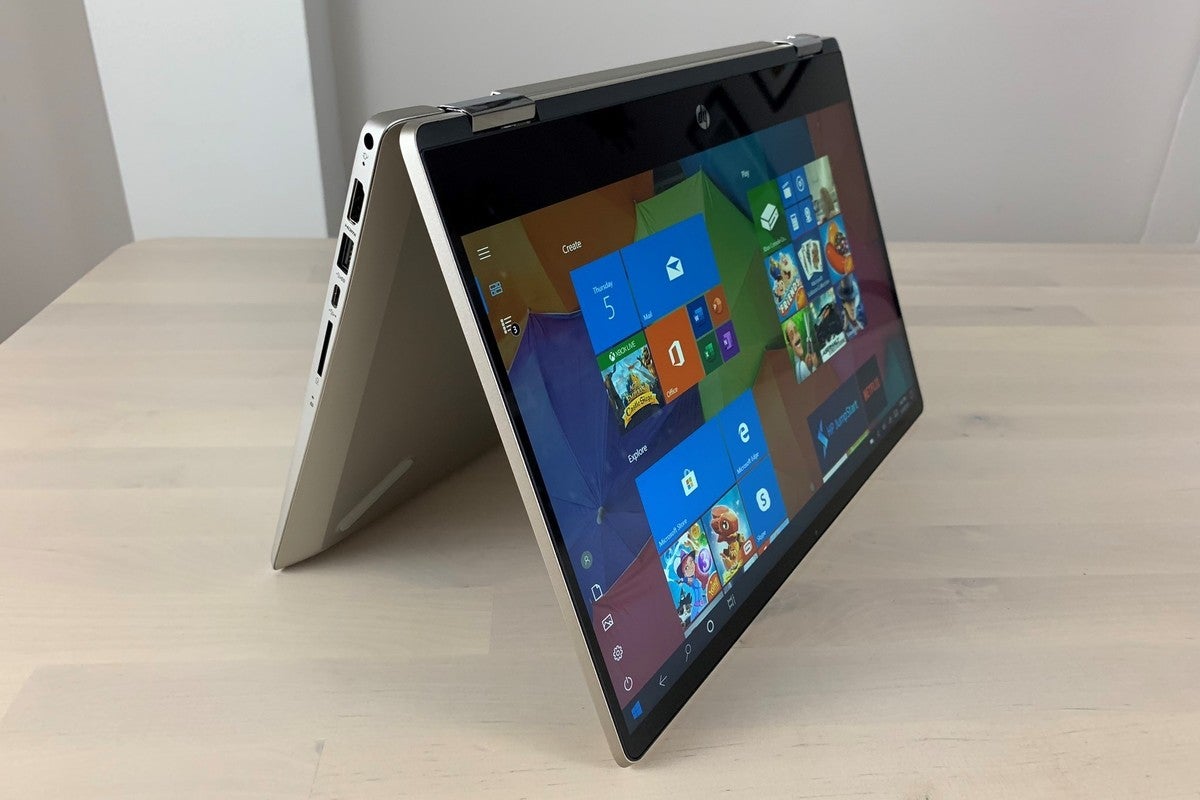 Ben Patterson/IDG
Ben Patterson/IDG As a 2-in-1 laptop, the HP Pavilion x360's lid can bend all the way around, perfect for tablet use or for tenting on a desktop.
One design element I didn't honey on the Pavilion x360 was the power button on the left edge of the laptop, near the eye. More than once, I accidentally put the Pavilion to sleep by inadvertently pressing the push as I was moving the laptop on my desk. A smarter move would have been to position the button further abroad from the middle—or, meliorate withal, put it just above the keyboard on the inside, where yous're much less likely to press it by blow.
Measuring 12.7 x eight.eight x 0.8 inches, the Pavilion x360 is reasonably thin for a convertible-way laptop. Weighing in at 3.62 pounds (or 4.19 if you lot include the power brick), the Pavilion feels a bit on the heavy side, and you'll definitely find the weight when yous're toting information technology effectually in a backpack.
Display
The Pavilion'south 1920×1080 display looks every bit sharp and vivid every bit we'd expect from a full-HD screen. With its IPS (in-airplane switching) display technology, the console boasts impressive viewing angles, dimming only slightly when viewed from the sides, top, or lesser.
The screen is a tiny bit dimmer than we'd like, measuring nearly 245 nits (or candelas), when our low-water mark for comfy indoor viewing is 250 nits. Then again, we've seen dimmer displays on laptops in this cost range, and I was able to view the Pavilion's display comfortably in my office. Outdoor viewing would likely be a dissimilar story.
Keyboard, trackpad, speakers, and extras
The Pavilion x360'south keyboard is a cut above those you typically see in mid-range laptops. The square, flat keys experience solid rather than squishy, with a fairly generous amount of travel and a satisfying mid-stroke bump that feels almost clicky. Indeed, I institute typing on the Pavilion to be an unexpected pleasance.
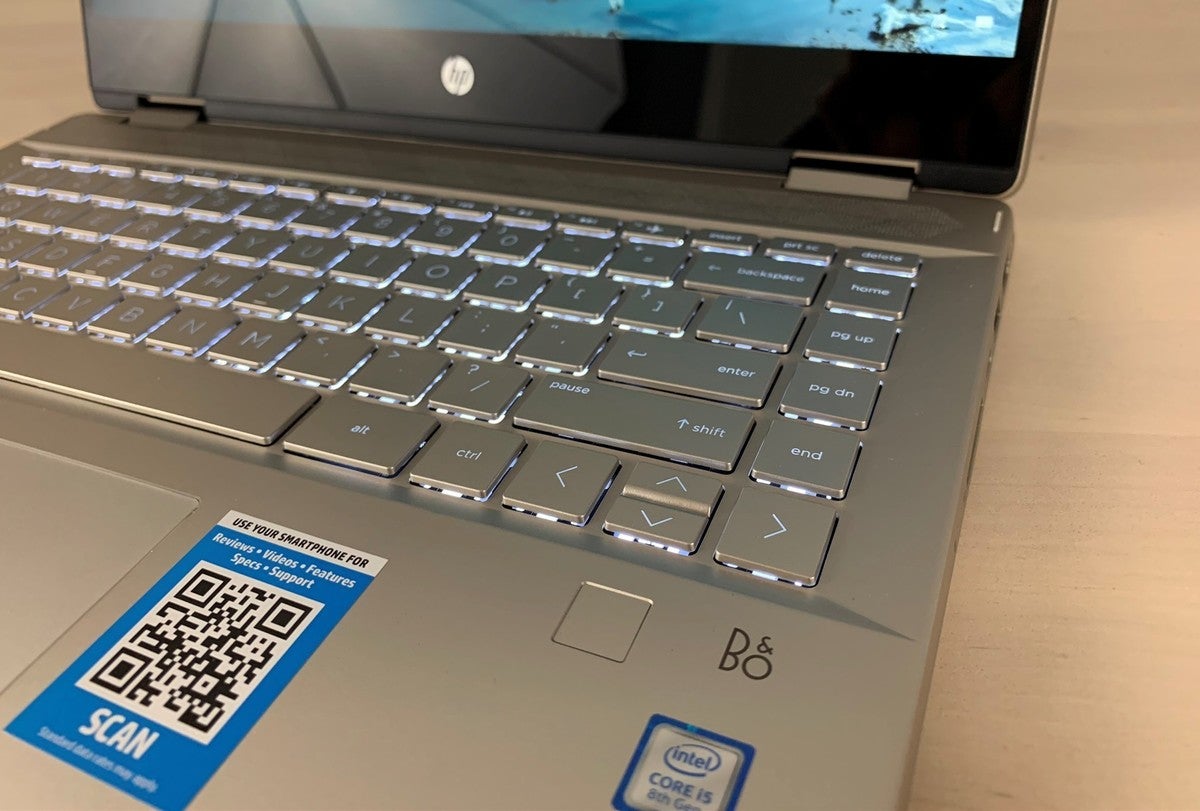 Ben Patterson/IDG
Ben Patterson/IDG The HP Pavilion x360's backlit keyboard is a pleasance to type on, with plenty of travel and solid, tactile primal caps.
The Pavilion's trackpad is a bit on the wide side, which meant that my palms frequently dragged over information technology while I typed. That wouldn't be a big bargain if the trackpad were better at rejecting accidental inputs; alas, the Pavilion's cursor occasionally jittered beyond the screen as my palm brushed the trackpad, particularly on the right side. The adventitious trackpad inputs weren't and so bad that they interrupted my work, but they happened plenty to be noticeable.
Back on the plus side, the Bang & Olufsen-designed stereo speakers are really pretty good. Nosotros generally expect very footling from laptop speakers, but the Pavilion'southward tiptop-firing drivers actually evinced some subtle detail and even a bit of bass. While I couldn't crank the speakers very loud, at least I didn't notice whatever distortion when I dialed the volume all the way upwardly.
This particular configuration of the Pavilion x360 comes with a fingerprint reader sitting just below the bottom-right corner of the keyboard.
Ports
The Pavilion x360 has a solid selection of ports given its size and toll range. Starting on the left side, there'south a USB iii.ane Gen i Blazon-A port (5Gbps), a philharmonic audio jack, and a laptop security slot. Too on the left side is a adept-sized cooling vent, along with the aforementioned ability push.
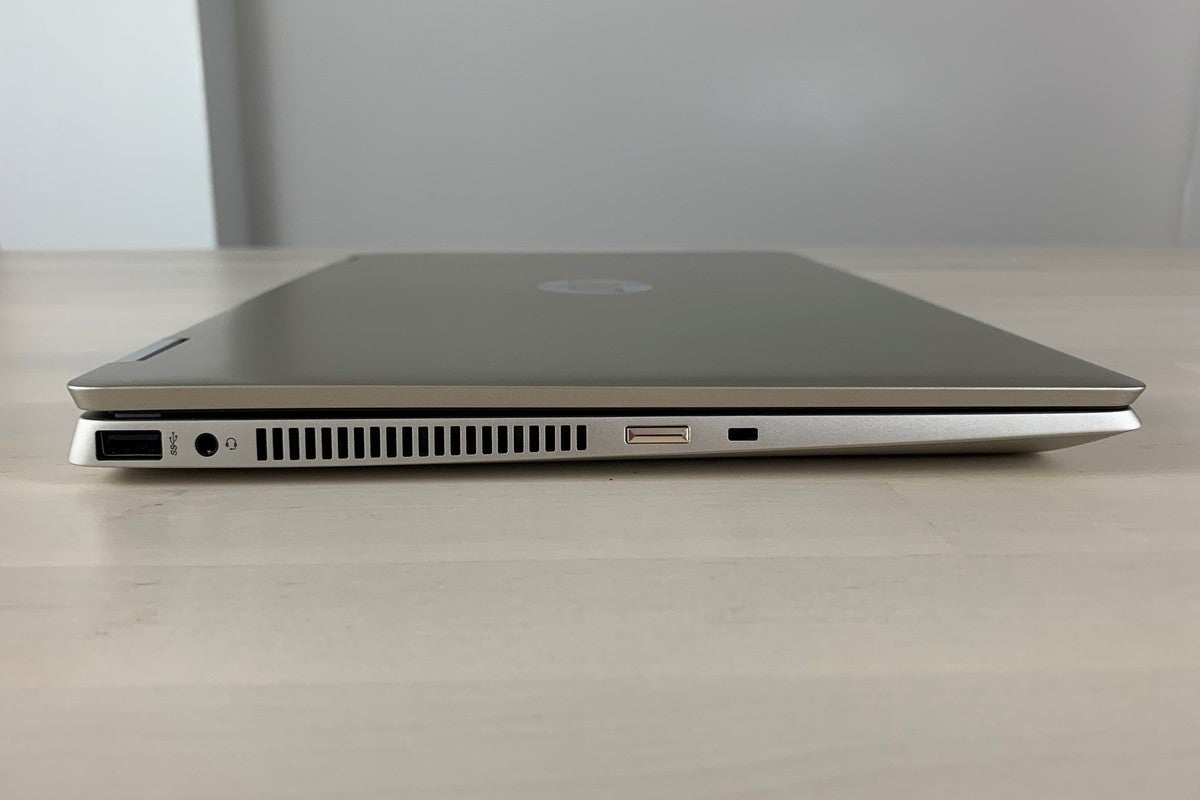 Ben Patterson/IDG
Ben Patterson/IDG On its left edge, the HP Pavilion x360 features a USB Type-A port, a combo sound jack, a big cooling vent, and a laptop security slot. Also on the left side: the ability push, which makes it a little too easy to press past accident.
On the right side you'll find a media menu reader, a USB iii.1 Gen 1 Type-C port, a 2d USB 3.1 Gen 1 Blazon-A port, a full HDMI port, and a butt-shaped charging connector.
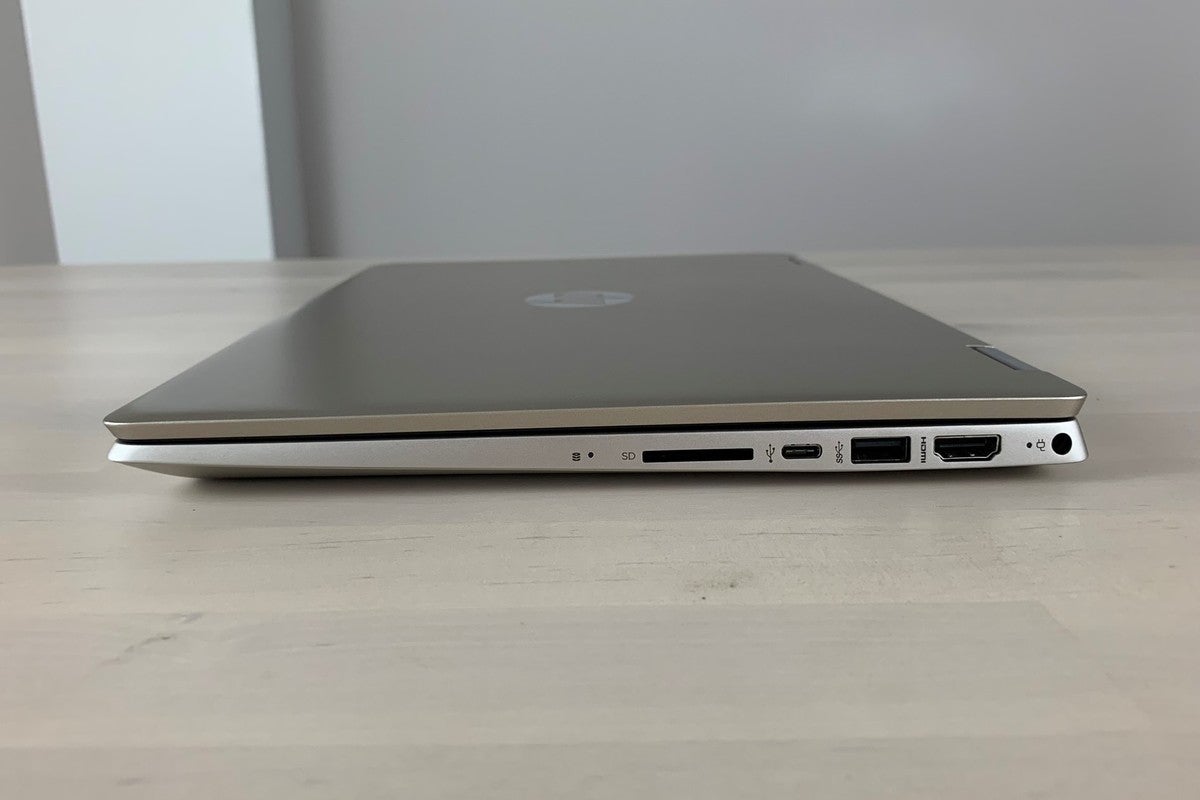 Ben Patterson/IDG
Ben Patterson/IDG Right-side ports include HDMI, USB Type-A, USB-C, and a media card reader.
There'south no ethernet port, but given that Pavilions generally don't have ane, that isn't much of a shock.
Performance
For our performance charts, we've grouped with HP Pavilion x360 with a mix of laptops, ranging from a eighth-gen, dual-cadre i3 model to a organization with Intel's latest six-cadre Ice Lake CPU, forth with a serial of quad-core laptops in the middle. Evidently, that Ice Lake chip is going to dust the Pavilion'southward less powerful Whiskey Lake CPU in some cases. Merely as we'll meet, the Pavilion gets a few chances to smooth fifty-fifty compared to the latest and greatest laptops, particularly when it comes to day-to-day productivity. Nosotros'll also meet how much of a difference a quad-core CPU makes compared to a dual-cadre flake like Intel's Cadre i3.
PCMark viii Piece of work 2.0 Conventional
Our kickoff benchmark simulates such daily computing tasks as web browsing, spreadsheet work, video chat, and other mutual desktop chores. Given that the HP Pavilion x360 should appeal most to productivity mavens, PCMark 8 is a great place to start with our testing. Generally speaking, a PCMark 8 score above 2,000 means you tin expect smooth Office functioning.
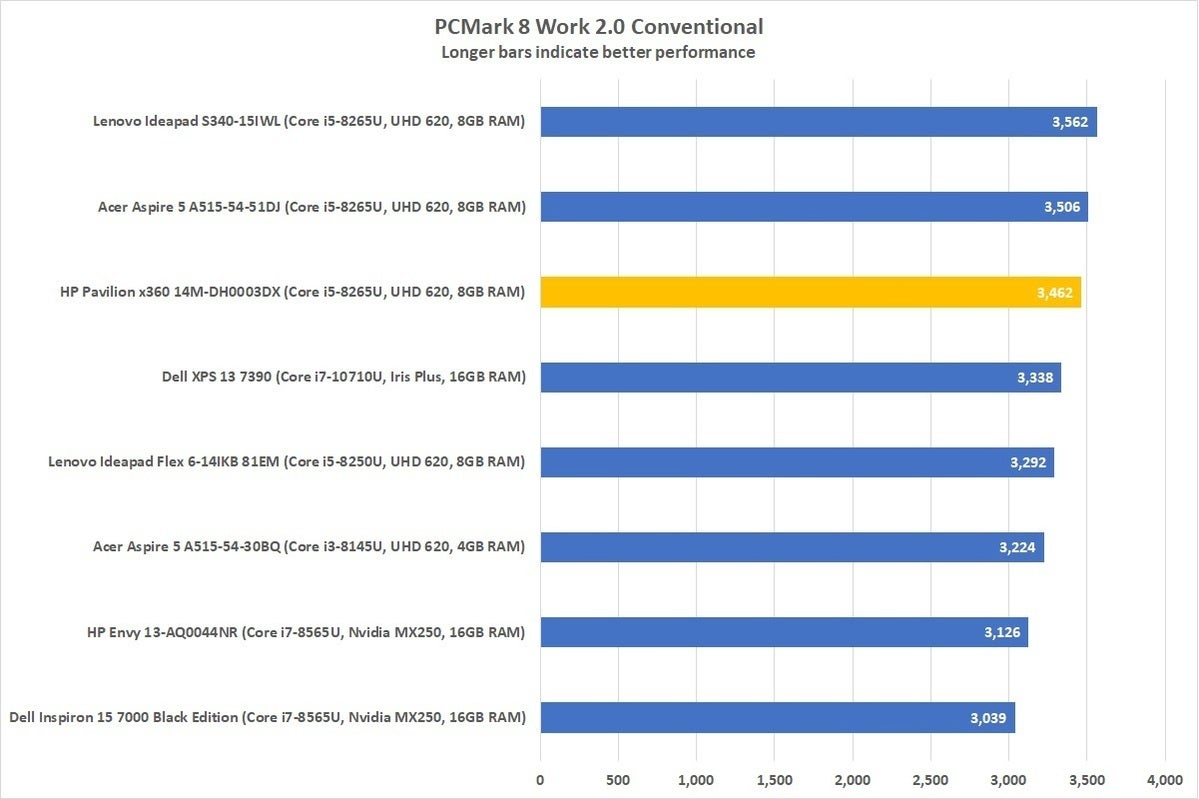 Ben Patterson/IDG
Ben Patterson/IDG With its solid PCMark 8 score, the HP Pavilion x360 should handle solar day-to-day computing tasks with ease.
A quick glance at the chart reveals that the Pavilion handled the PCMark 8 benchmark like a gnaw, and information technology even edged the Dell XPS thirteen 7390 with its six-core Water ice Lake CPU. To be off-white, though, the cadre count doesn't really matter so much with PCMark eight, which focuses mostly on single-cadre applications. Information technology'southward also worth noting that the Dell is much thinner and lighter than the Pavilion, which means information technology must pump the brakes to keep its slim chassis cool.
In the end, which laptop finished where in our nautical chart really doesn't matter given that they all notched scores northward of iii,000. In other words, all of these laptops are cracking Part machines.
HandBrake
A criterion that involves converting a 30GB MKV file into a format suitable for an Android tablet, our HandBrake test pushes even the beefiest CPUs to their limits. It likewise tells u.s.a. a lot near how a given laptop balances cooling and operation over a relatively lengthy period, given that our HandBrake test frequently takes more than an hr to perform.
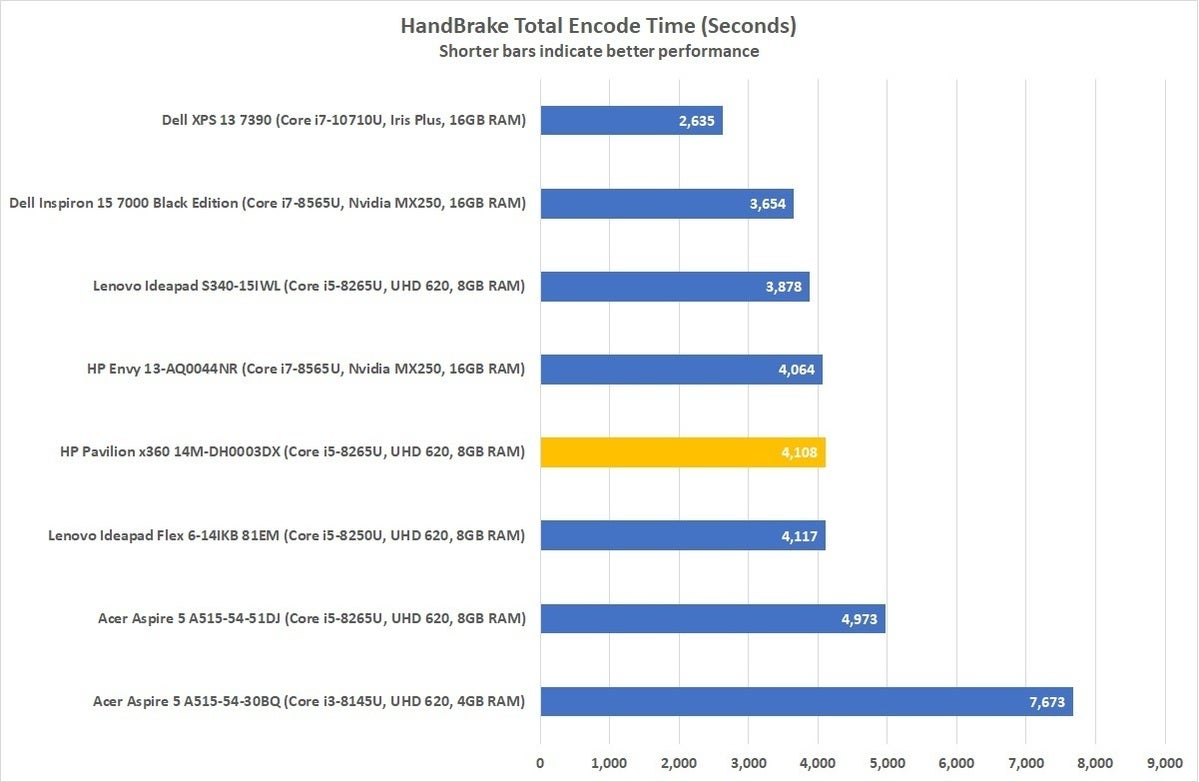 Ben Patterson/IDG
Ben Patterson/IDG With its quad-core i5 CPU, the HP Pavilion x360's HandBrake functioning sits right where it should, with the 6-cadre Dell XPS 13 unsurprisingly at the top of the heap.
Checking our nautical chart, the HP Pavilion x360 lands pretty much where nosotros'd look, right in the mix with other quad-core Cadre i5 Whiskey Lake laptops. The Pavilion is besides cervix-and-cervix with the HP Envy 13, a Core i7 Whiskey Lake laptop. That's actually not as surprising equally it sounds, equally the main departure betwixt the i5 and i7 fries is that the i7 boasts a higher heave clock, an advantage that's most apparent during brusque, intense bursts of CPU activeness.
The nautical chart-topping Dell XPS xiii and its Ice Lake CPU illustrate the substantially superior functioning of a (far pricier) six-cadre processor compared to a quad-cadre system, although y'all by and large don't need that kind of horsepower unless you're dealing with, say, 4K video workflows. On the other terminate of the spectrum is the dual-core Acer Aspire 5, which lags well backside the pack but does merely fine (and for a lot less) when it comes to daily, unmarried-core productivity tasks.
Cinebench
Remember what we said a moment ago about short bursts of CPU activeness? That's what our Cinebench test, which involves rendering a 3D image in real time, is all about. Unlike the lengthy HandBrake benchmark, which can take an hr or more, Cinebench is typically all over inside 5 minutes or so.
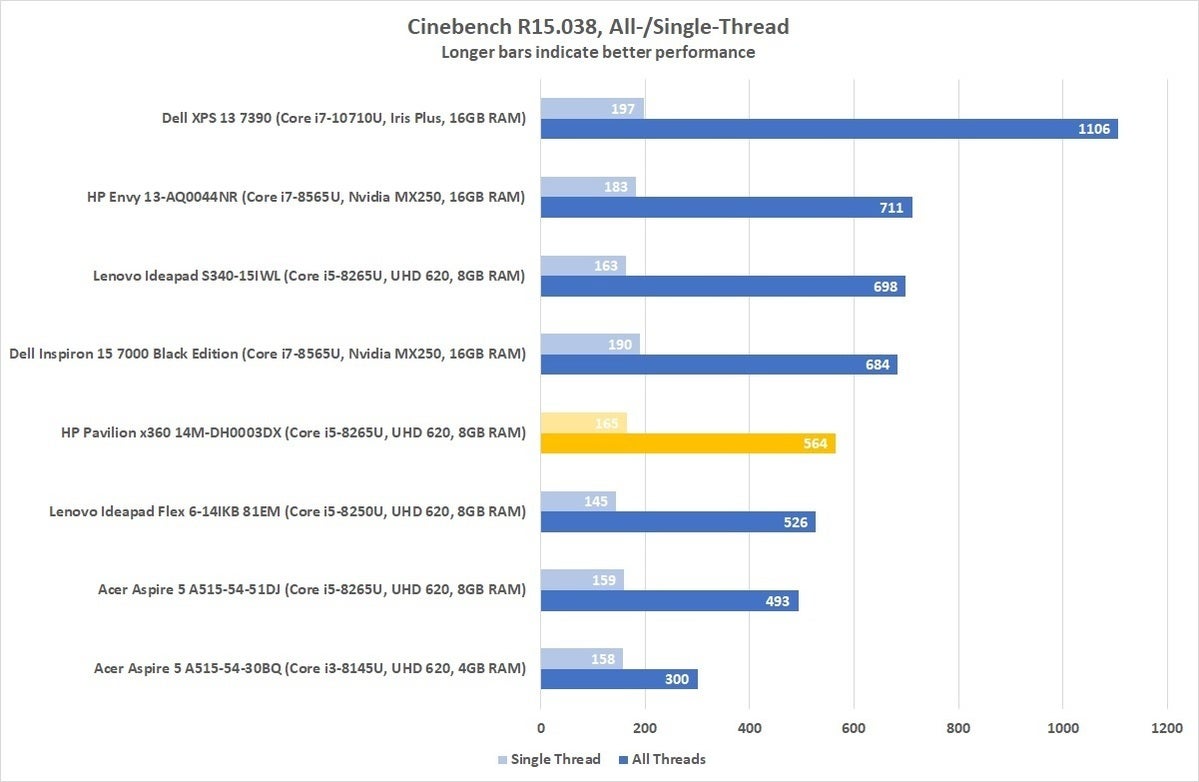 Ben Patterson/IDG
Ben Patterson/IDG Again, no surprises with the HP Pavilion x360's Cinebench performance. If yous consider its single-thread score, the Pavilion actually moves upward a notch.
Once over again, the HP Pavilion x360's Cinebench score was bunched up with its beau i5-packing laptops, albeit nearer to the bottom. The Paviion's so-and so performance tin be partly blamed on its two-in-1 form cistron, which is tougher to keep absurd than a traditional clamshell laptop is. Yet, nosotros should note that the Pavilion x360's all-threads Cinebench score is respectable given its CPU, while its solid unmarried-thread Cinebench result (which is all that matters when it comes to day-to-twenty-four hours computing tasks) brings it upwardly a notch.
Looking at the contest, we see the half-dozen-core Ice Lake-powered Dell XPS 13 mode ahead of the pack (no surprise there), while the quad-core HP Envy 13 and its Core i7 CPU ges an expected speed bump cheers to its faster heave clock. At the lesser of the listing, once once again, is the dual-core but deal-priced Acer Aspire 5.
3DMark Sky Diver
Like many mid-range, productivity-minded laptops, the HP Pavilion x360 isn't much of a gaming motorcar, although its integrated graphics core is designed to deliver enough adequate operation for lite photo editing and similar tasks. As a rule, laptops with discrete graphics cards volition score much higher in our graphics-oriented 3DMark Sky Diver benchmark, and our results acquit that out.
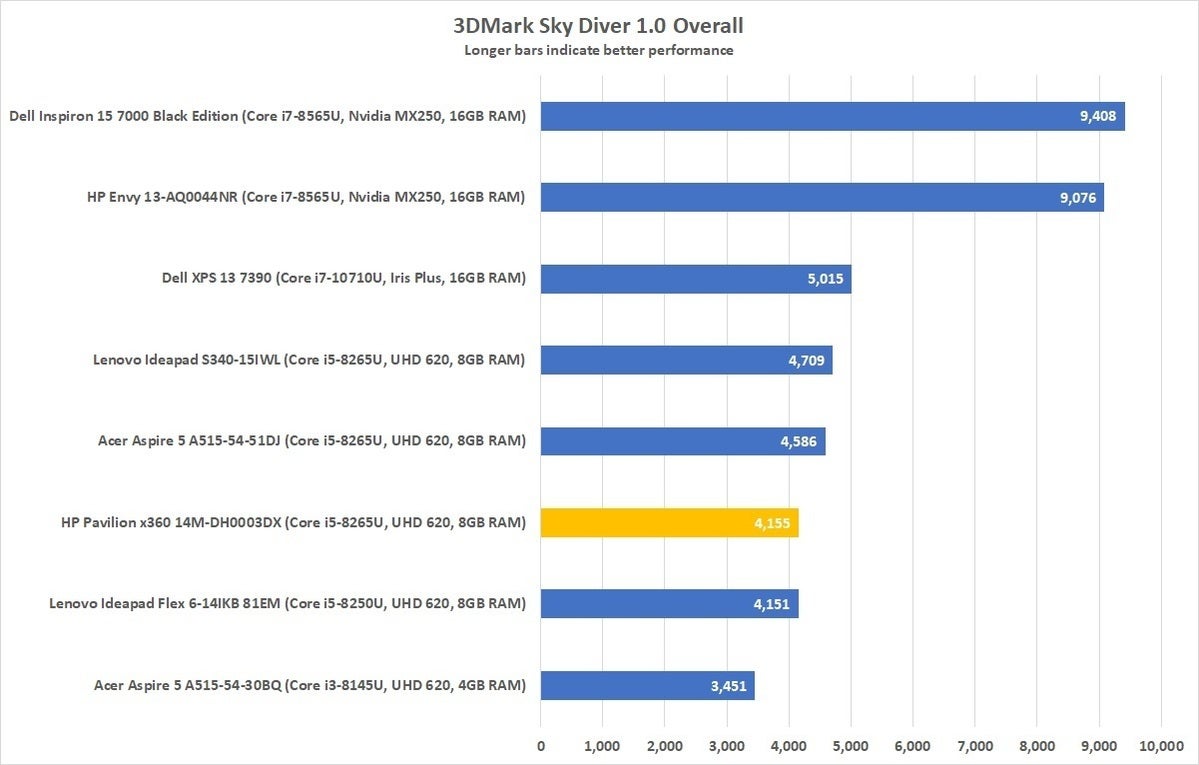 Ben Patterson/IDG
Ben Patterson/IDG Without detached graphics, the HP Pavilion x360 isn't much of a gaming machine, but that likely won't matter to productivity-minded users.
As expected, the HP Pavilion x360 sits correct aslope similar laptops with integrated Intel UHD Graphics 620 cores. While it's nearer the dorsum of the pack, you're not going to see whatever of these integrated graphics systems deliver fifty-fifty close to thirty fps while playing, say, Fornite. For smooth gaming performance, you'd demand a laptop with discrete graphics, such as the two laptops at the superlative of our nautical chart, which both boast entry-level Nvidia GeForce MX250 graphics cards.
Battery life
We test a laptop's battery life by looping a 4K video using the stock Windows Movies & TV app. We set screen brightness set to about 250 nits (which means cranking the brightness all the way up on the HP Pavilion x360) and with the book ready to fifty pct, headphones on.
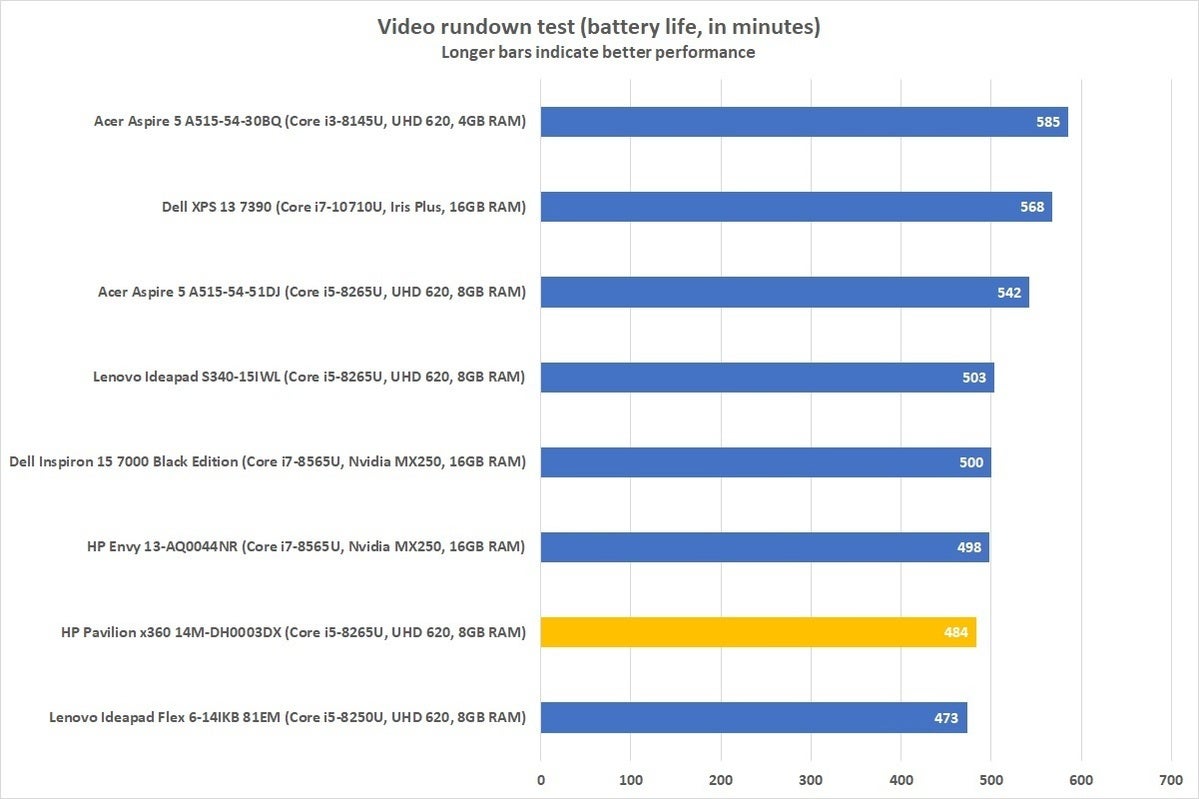 Ben Patterson/IDG
Ben Patterson/IDG The HP Pavilion'southward battery life isn't bad because its smallish battery, just nosotros still wish it had a bigger one.
At showtime glance, the Pavilion's position near the bottom of the chart doesn't look so great, but its 484-minute battery drain result (a sliver over eight hours) isn't bad because its forty-watt-hour battery, which is the smallest of the agglomeration. It even beats out that of the 14-inch Lenovo IdeaPad Flex, a 2-in-1 laptop with a larger 48-watt-hour bombardment.
Yet, if yous're looking for a system that'll last you more than a long afternoon on battery ability (and continue in mind that our viii-60 minutes battery drain result won't concord upwardly if you're doing annihilation remotely demanding on the Pavilion), you should consider a device with a bigger bombardment. The relatively low-priced Acer Aspire 5'due south 48Wh battery managed to last 100 minutes longer during our battery drain test. It's too a good three-quarters of a pound heavier than the Pavilion.
Bottom line
While its battery life and brandish are mediocre, the HP Pavilion x360 remains a solid, well-built ii-in-1 that will speed y'all through everyday calculating tasks too as moderately tough video-processing or number-crunching chores. Amend nonetheless, its comfortable keyboard will go on your fingers happy, and the surprisingly decent-sounding speakers will proceed yous humming. For the price (peculiarly at electric current discounts), information technology's a solid bargain.
garciacrivair1974.blogspot.com
Source: https://www.pcworld.com/article/398489/hp-pavilion-x360-14m-dh0003dx-2-in-1-review.html
0 Response to "Hp Pavilion X 360 2 in 1 Touch Screen 14m Cd0003dx I5 Review Pc Magazine"
Post a Comment